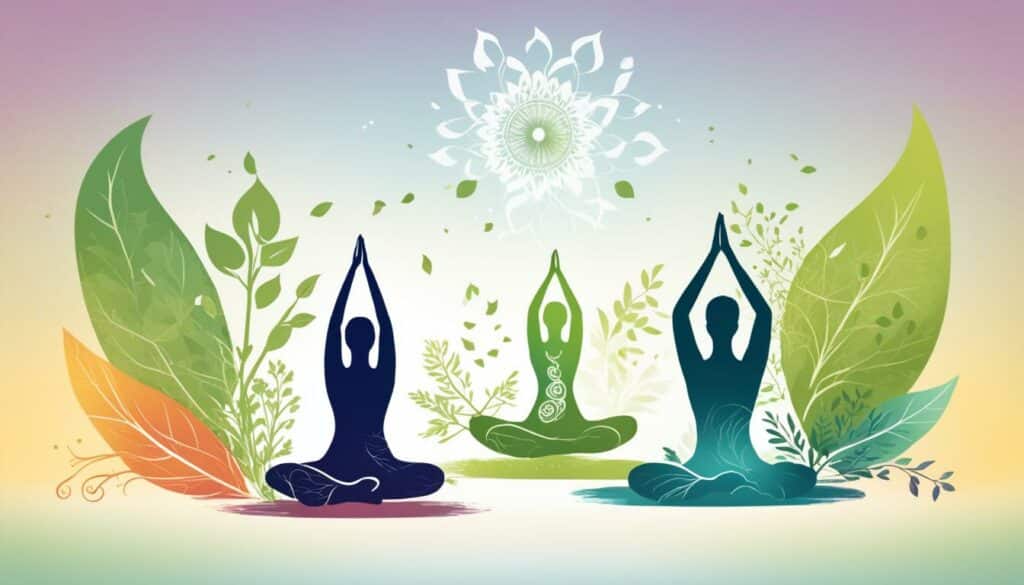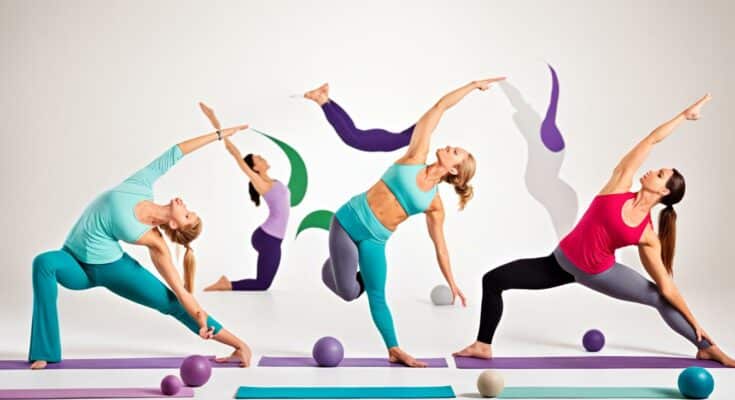Are you curious about how many yoga positions are there? Yoga is a practice that involves a combination of physical postures, breathing exercises, and meditation techniques. It has been around for thousands of years and has evolved into a vast array of poses that cater to different needs and abilities.
In contemporary yoga, there are approximately 200 different yoga poses. However, it’s important to note that the number of poses described in ancient yoga traditions varies. The oldest yoga traditions mainly focused on sitting poses for meditation, with only a few poses mentioned. Medieval hatha yoga traditions recognized 84 poses, while other ancient texts mention different numbers ranging from 2 to 122 poses. In the 20th century, renowned yoga masters introduced even more poses, with descriptions ranging from 180 to over 200 poses.
Beyond the 200 distinct poses, many variations of existing poses can be found. The Indian government’s Traditional Knowledge Digital Library (TKDL) contains a wealth of information on ancient yogic techniques, including purification processes, movements, mudras, bandhas, pranayama, meditation techniques, yantras, and mantras.
Key Takeaways:
- Contemporary yoga consists of approximately 200 different yoga poses.
- Ancient yoga traditions recognized fewer poses, with the number ranging from 2 to 122.
- Some renowned yoga masters introduced even more poses, with descriptions ranging from 180 to over 200.
- The Indian government’s Traditional Knowledge Digital Library (TKDL) contains information on various ancient yogic techniques.
- Beyond the distinct poses, many variations of existing poses exist.
Evolution of Yoga Poses throughout History
In the early days of yoga, poses primarily served as stable sitting positions for meditation and breathing exercises. The ancient texts mention only a few poses, mainly those for seated meditation. However, as time went on, the number of yoga poses described grew, reflecting the evolving practices and concepts of yoga.
Yoga poses, or asanas, began to encompass a wider range of movements and postures. The inclusion of inversions, forward bends, twists, backward bends, and eventually standing postures expanded the repertoire of yoga poses.
“Yoga takes you into the present moment, the only place where life exists.” – Patanjali
The 20th century witnessed a significant expansion in the understanding and practice of yoga asanas. The development of new physical training techniques, along with the ability to create accurate drawings and images of the human body, contributed to the growth in the number and complexity of yoga poses.
The evolution of yoga asanas can be attributed to various factors, including the influence of different yoga traditions, the integration of physical culture, and the exploration of the mind-body connection in yoga practice.
Table: Evolution of Yoga Poses
| Time Period | Development |
|---|---|
| Ancient Times | Basic seated poses for meditation |
| Medieval Era | Addition of inversions, forward bends, twists, and backward bends |
| 20th Century | Expansion to include standing postures and a variety of movements |
Throughout history, yoga asanas have evolved to meet the changing needs and interests of practitioners. The ancient yoga poses provided a foundation for seated meditation, while modern yoga asanas allow for a comprehensive approach to physical and spiritual well-being.
As yogis continue to explore the practice of asanas, new postures and variations are being discovered, adding depth and complexity to the ancient tradition of yoga.
The Significance and Purpose of Yogasanas
Yogasanas go beyond physical exercise; they are subtle processes that manipulate energy in a specific direction. By consciously practicing asanas, one can enhance their consciousness and change the way they feel, think, understand, and experience life. Asanas help in balancing the masculine and feminine energies within the body, leading to a higher possibility of wellbeing. They also create a conducive atmosphere for spiritual practices by preparing and aligning the body and mind.
The practice of asanas can enhance perception and bring about a union between the inner and outer dimensions of experience.

| Benefits of Yogasanas |
|---|
| Enhanced consciousness |
| Balancing of masculine and feminine energies |
| Improved wellbeing |
| Preparation and alignment of body and mind for spiritual practices |
| Enhanced perception and connection between the inner and outer dimensions of experience |
The Science and Mastery of Yogasanas
Yogasanas are an integral part of hatha yoga, a discipline that aims to bring balance between the sun and moon energies within the body. The practice of yogasanas goes beyond physical exercise, delving into the profound knowledge and experience that can be attained through mastery of each individual pose.
Flexibility is a key component during asanas, as it allows the body to move freely and explore the full range of motion. It enables practitioners to deepen their poses, enhancing the overall effectiveness of the practice. In addition, flexibility contributes to the prevention of injuries and promotes joint health.
The sequence of poses in a yoga practice is important for creating a flow of energy. A well-structured sequence takes into consideration the different effects of various asanas and ensures a balanced practice. This harmony of movements allows for a smoother transition between poses, promoting a sense of fluidity and grace.
Focusing on the breath during yogasanas is essential to maintain awareness and establish a deep connection with the body. Conscious breathing helps cultivate a calm and focused mind, enabling practitioners to be fully present in each pose. It also facilitates the release of tension and promotes relaxation, enhancing the overall experience of the practice.
To deepen the practice of yogasanas, there are additional factors to consider. Closing the eyes during certain poses can intensify the inward focus and facilitate a deeper connection with the self. Toe to toe alignment helps maintain stability and proper weight distribution, while the heel to perineum connection provides grounding and stability during standing poses.
The practice of asanas is an invitation to explore the boundaries of the body and mind. It cultivates ease and stability within the physical body, allowing practitioners to discover their own unique potential and capabilities. Through regular practice and dedication, yogasanas provide a pathway to self-discovery and personal growth.

Asanas and Their Effects on the Body and Mind
Different asanas have profound effects on the body and mind, offering a plethora of benefits that contribute to overall physical and mental wellbeing. Through the practice of yoga poses, individuals can stimulate or calm their nervous system, enhance flexibility, improve stamina and strength, and increase focus and concentration. Additionally, specific asanas provide a stable and comfortable sitting posture, making them particularly beneficial for meditation.
Asanas play a significant role in promoting balance between the body and mind, allowing practitioners to gain insights into their interconnectedness. By exploring various yoga poses, individuals can begin to understand how their physical and mental states work together and how they can be transformed through dedicated practice. Let us delve deeper into the effects and benefits of different asanas.
The Physical Effects of Asanas
Practicing different yoga poses can have a profound impact on the physical body. Asanas help to:
- Stimulate or Calm the Nervous System: Some asanas activate the sympathetic nervous system, increasing energy and invigorating the body. Others promote relaxation and activate the parasympathetic nervous system, helping to reduce stress and induce a state of calmness.
- Enhance Flexibility: Regular practice of asanas promotes flexibility, improving joint mobility and muscular range of motion. This increased flexibility can lead to improved posture and a reduced risk of injuries.
- Improve Stamina and Strength: Many yoga poses require sustained effort, which helps to build stamina and endurance. Asanas that incorporate weight-bearing on the arms and legs also contribute to strength development.
The Mental and Emotional Effects of Asanas
Alongside the physical benefits, yoga poses can also have a profound impact on mental and emotional well-being. Asanas help to:
- Increase Focus and Concentration: The practice of asanas requires mindfulness and concentration, training the mind to stay present in the moment. This focused attention can extend beyond the yoga mat, improving concentration and mental clarity throughout daily life.
- Promote Overall Wellbeing: Asanas can release physical tension and promote a sense of relaxation and ease. This release of tension in the body can have a positive impact on mental and emotional well-being, reducing stress, anxiety, and promoting a sense of overall peace and balance.
By incorporating a variety of yoga poses into your practice, you can experience the transformative effects they have on both the body and mind, unlocking your full potential and enhancing your overall quality of life.
| Effect | Description |
|---|---|
| Stimulate or Calm the Nervous System | Asanas can activate or relax the nervous system, depending on the pose, helping to energize or calm the body and mind. |
| Enhance Flexibility | Regular practice of asanas improves joint mobility and muscular flexibility, supporting better posture and reducing the risk of injuries. |
| Improve Stamina and Strength | Asanas that engage the muscles and require sustained effort contribute to building stamina and strength in the body. |
| Increase Focus and Concentration | The mindful practice of asanas enhances mental focus and concentration, training the mind to stay present in the moment. |
| Promote Overall Wellbeing | Asanas release physical tension, promoting relaxation and a sense of overall well-being, reducing stress and anxiety. |
Exploring Asanas in Depth
While the basic yoga postures provide a solid foundation, there is a world of advanced asanas waiting to be explored. These poses, which require a deeper level of awareness and skill, offer specific benefits for practitioners seeking balance, strength, flexibility, and inversions.
Each asana has its own variations and modifications, allowing for endless possibilities for customization. Even the simplest pose can be explored in depth, revealing its hidden potential and allowing for a more profound experience.
Here are some popular asanas that can take your practice to the next level:
- Downward-Facing Dog – This pose stretches and strengthens multiple muscle groups, including the arms, shoulders, hamstrings, and calves. It also helps improve posture and relieve stress.
- Half Moon Pose – This standing balance pose improves overall body coordination, strengthens the legs and core, and enhances focus and concentration.
- Cobra Pose – This backbend pose opens the chest, stretches the shoulders and abdomen, and strengthens the back muscles. It also aids in relieving back pain.
- Tree Pose – This balancing pose cultivates focus, stability, and concentration. It strengthens the legs and improves overall body alignment.
By incorporating these advanced asanas into your practice, with regular practice and guidance, you can deepen your understanding and experience of yoga.
| Asana | Benefits | Variations |
|---|---|---|
| Downward-Facing Dog | Improves strength, flexibility, and posture | Variation 1: Three-Legged Downward Dog |
| Half Moon Pose | Enhances balance, coordination, and focus | Variation 1: Revolved Half Moon Pose |
| Cobra Pose | Stretches and strengthens the back, improves posture | Variation 1: Upward-Facing Dog |
| Tree Pose | Builds stability, focus, and leg strength | Variation 1: Dancing Tree Pose |
As you explore these advanced asanas, remember to listen to your body, take it at your own pace, and seek guidance from a qualified yoga instructor. With dedication and patience, you can unlock the full potential of these poses and reap the benefits they offer.
Fine-Tuning Your Asanas
When it comes to refining your yoga poses, there are several key aspects to consider in your asana practice. Paying attention to these elements can greatly enhance your journey and maximize the benefits of each pose.
Maintaining Flexibility
Flexibility is a crucial component of asana practice. It allows for greater extension and range of motion, enabling you to deepen your poses and explore new variations. Regular stretching and gentle warm-up exercises can help improve your flexibility over time. Remember, progress comes with patience and consistent effort.
Practicing Proper Alignment
Alignment plays a vital role in asanas. It ensures that your body is in the correct position to optimize the benefits of each pose while minimizing the risk of injury. Focus on aligning your spine, hips, shoulders, and other body parts as instructed by your teacher or through proper guidance. With practice, you’ll develop a better sense of alignment, allowing you to refine your poses and experience their full potential.
Focusing on the Breath
The breath is a powerful tool for awareness and concentration during asanas. By syncing your breath with the movements, you create a rhythmic flow that promotes mindfulness and helps you stay present in the practice. Use deep, steady breaths to cultivate a sense of calm and inner connection. The breath acts as a guide, leading you deeper into the practice and facilitating a harmonious mind-body connection.
Following a Set Sequence
A structured sequence can bring rhythm and balance to your asana practice. It helps create a flow that builds upon each pose, ensuring a gradual progression and a comprehensive full-body experience. Following a set sequence also allows you to track your progress and notice subtle changes in your performance and alignment. Many styles of yoga, such as Ashtanga and Vinyasa, incorporate specific sequences that provide a framework for consistent growth and improvement.
“Fine-tuning your asanas involves maintaining flexibility, practicing proper alignment, focusing on the breath, and following a set sequence.”
It’s important to remember that asanas require concentration and awareness. Avoid talking during the practice, as it can disrupt your focus and interrupt the flow of energy. Instead, cultivate inner stillness and allow yourself to fully immerse in the present moment.
By refining these essential aspects of asana practice, you can elevate your yoga journey and experience the transformative power of each pose. Embrace the process, listen to your body, and explore the depths of your practice.
As you refine your asanas, the image above serves as a visual reminder of the beauty and grace that can be achieved in each pose. Let it inspire you to dive deeper into your practice and unlock your true potential.
Conclusion
Yogasanas have evolved over time, from simple seated poses for meditation to a wide variety of postures that encompass physical, mental, and spiritual aspects. With approximately 200 yoga poses in contemporary yoga, the ancient traditions recognize fewer poses, with some texts mentioning 84 as the ideal number.
The practice of asanas goes beyond physical exercise and offers numerous benefits for the body and mind. By exploring the science and mastery of asanas, one can experience the transformative power of yoga. Fine-tuning asanas and delving deeper into their effects can enhance the practice and allow for a more profound connection with the self and the world.
Whether you are a beginner or an advanced practitioner, the journey of yogasanas is one of self-discovery and growth. Through dedicated practice and seeking guidance, you can unlock the potential of each asana and gain a deeper understanding of their effects on the body and mind. By incorporating yogasanas into your daily routine, you can experience improved flexibility, strength, balance, focus, and overall well-being.
FAQ
How many yoga positions are there?
In total, there are about 200 yoga poses in contemporary yoga.
What is the history of yoga poses?
The earliest texts mention only a few poses, mainly those for seated meditation. Over time, more poses were added, including inversions, forward bends, twists, backward bends, and eventually standing postures.
What is the purpose of yogasanas?
Yogasanas go beyond physical exercise and aim to balance the masculine and feminine energies within the body. They also create a conducive atmosphere for spiritual practices and help enhance perception and bring about a union between the inner and outer dimensions of experience.
How can yoga poses benefit the body and mind?
Different asanas have different effects, such as stimulating or calming the nervous system, enhancing flexibility, improving stamina and strength, increasing focus and concentration, and promoting overall wellbeing. Some asanas are particularly beneficial for meditation as they create a stable and comfortable sitting posture.
Can yoga poses be explored in depth?
Yes, there are numerous asanas that go beyond the basic postures. Advanced asanas require a deeper level of awareness and can aid in specific purposes such as balance, strength, flexibility, and inversions. Each asana has its own variations and modifications.
What aspects are important for refining asanas?
Flexibility, proper alignment, breath focus, and following a set sequence are important aspects to refine asanas. Flexibility allows for greater extension and range of motion, alignment optimizes the benefits of the pose, breath focus maintains awareness, and a set sequence creates flow and rhythm during the practice.
How do yoga poses evolve over time?
Yoga poses have evolved from simple seated poses for meditation to a wide variety of postures that encompass physical, mental, and spiritual aspects. There are now approximately 200 yoga poses in contemporary yoga.




